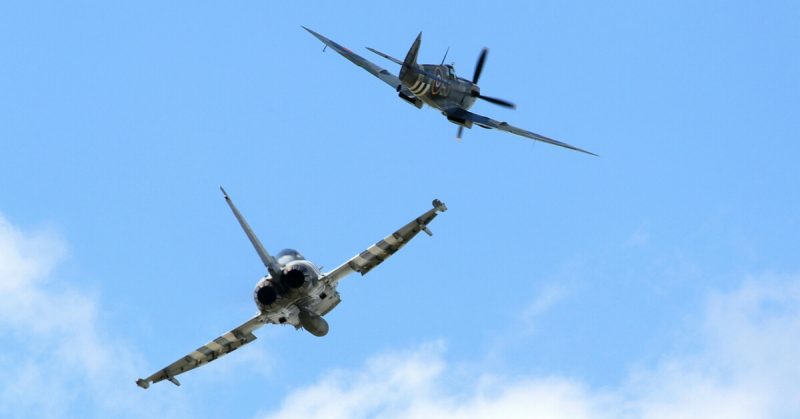What U.S. test pilot Chuck Yeager achieved, on October 14, 1947, had long been considered impossible. In his Bell X-1 rocket plane, he became the first man to officially fly faster than the speed of sound.
Other pilots came very close in previous years. While they fell short of the history books, their flights were more impressive in some ways because their planes were not designed for that speed. Just getting close to the speed of sound could break the plane into multiple pieces.
There were a number of flights that took place with British Supermarine Spitfires, the ubiquitous single-seat fighter plane which helped win the Battle of Britain. These flights were crucial to helping scientists understand the forces that act on a plane at those high speeds.
RJ Mitchell designed the Spitfire and it entered service just before World War II.
Later models could fly over 400mph in level flight due to the powerful Rolls-Royce Merlin engine and the four-bladed propeller. Photo reconnaissance versions of the plan could go even faster without the weight of machine guns or ammunition to weigh them down.
The Spitfire’s fantastic performance also made it perfect for test flights in high-speed research. On these test flights, pilots sometimes took the plane further than it had ever gone before, facing the powerful aerodynamic forces that occur near the sound barrier.
High-speed trials began in 1943. On one flight, Squadron Leader JR Tobin sent his Mark XI Spitfire into a 45-degree dive; the plane reached a top speed of 606mph. This was the fastest a Spitfire had ever flown – without the pilot dying along the way.
In April 1944, Squadron Leader Anthony F. Martindale put another Mark XI Spitfire into a dive. The reduction gear that limit the speed of the aircraft broke. The propeller ripped off. The aircraft reached Mach .92.
It was simple physics that saved Martindale. When the propellers ripped off, the tail-heavy aircraft changed pitch and the plane rapidly began climbing – knocking Martindale out in the process. When he came to, the aircraft was flying at 40,000ft. He somehow managed to glide the plane back to the base and walked away unhurt.
The wings were dramatically bent, however. The warping was caused by the airflow over the wing, according to Rod Irvine, the Royal Aeronautical Society’s aerodynamics group chairman.
“When you start approaching Mach 0.85 or 0.95,” Irvine explains, “what happens is you get this subsonic flow over the wing, and it starts to accelerate beyond the sound barrier. It starts to flick around all over the place, and it feels like the aircraft is starting to shake itself to bits because you get this fundamental change in the aerodynamics.”
Irvine says this is still a problem today. Airliners like the Airbus A380 fly as fast as possible without allowing the air over the wings to reach supersonic speed in order to avoid the vibrations and buffeting.
The other problem the Spitfires had was the propeller. Aircraft were made with the propeller directly connected to the engine. This provided more power to the propeller, allowing it to spin faster. Even at speeds under 300mph, the air travelling over the blades could reach supersonic speed. The shock waves formed by the fast-moving air added drag, buffeting and noise.
Jeremy Kinney is a curator at the Smithsonian Air and Space Museum in Washington, DC. He says that RJ Mitchell had understood some of these design issues with propellers from his time designing racing airplanes in the early 1920’s.
“Say you’re standing under one of those racing planes at an air racing event at Cowes on the Isle of Wight in 1923,” says Kinney. “You’d hear this banging and clanking as the aircraft went overhead. That’s the tips of the propellers going supersonic.”
Mitchell and other designers of the time realized that simply making the propeller go faster wouldn’t necessarily make the plane go faster. Variable pitch propellers matched the speed of the propeller to the RPM of the engine. These were more efficient and helped planes like the Spitfire fly faster.
“The combination of the piston engine and the propeller are a kind of symbolic limitation of ever-increasing speed,” Kinney adds. “It builds the case for how monumental the turbojet revolution was. You can only get a piston engine to do so many revolutions per minute.
“There was this paradigm, at least for the first half of the 20th Century, that planes had to go higher, faster and further. The work required to make a propeller that could work through the supersonic regime was just too much – and why try, when the jet engine suddenly gives you that capability?”
The high-speed dives in Spitfires and other planes, like the American P-51 Mustang and P-47 Thunderbolt, helped give researchers the information they needed to design planes for supersonic flight. Planes would be built with pointed noses, smaller wings, and a smooth fuselage that would limit the effect of shockwaves. In other words, they would be built like Yeager’s Bell X-1.
